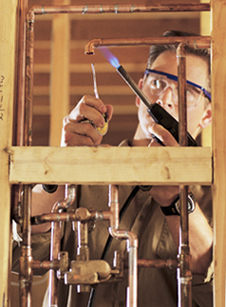
The Bay Area Pollution Prevention Group is reminding contractors that incorrectly installed copper water pipes can increase the copper concentration in drinking water above national water quality standards. The group comprises several San Francisco Bay Area counties and agencies that monitor wastewater delivery systems that eventually enter the bay.
When not constructed or repaired with care, copper from pipes used in residential and commercial construction can cause gastrointestinal upset and other health problems, while metal shavings left in the pipe can impact water taste and odor. The pollution prevention group encourages contractors to take steps to reduce the amount of copper that leaches into a building's or home's drinking water by using the correct soldering flux, and thoroughly flushing newly soldered pipe.
- Minimizing pipe direction and size changes (This helps reduce turbulence and reduce corrosion over the life of the pipe.)
- Carefully cleaning and reaming the cut pipe to eliminate small burrs created from pipe cutting (This cleaning prevents metal shavings from causing taste/odor issues and reduces turbulence and corrosion.)
- Removing all oxides, debris, and surface soil from tube ends
- Using the correct flux, and avoiding excess (Only select flux that complies with the "ASTM B813" standard—check the label; avoid petroleum-based flux as it cannot be effectively flushed out of the pipe; avoid ammonia-based flux as it attracts bacteria, which may impact taste and odor; avoid zinc-based flux due to water quality impact; and avoid using excess flux—residue can increase pipe corrosion.)
- Immediately flushing the system to remove excess flux that would attack the pipe over time; removing all sink aerator and strainer screens; and flushing the system at a robust velocity for at least 30 minutes
- Minimizing the building's hot water temperature (A system temperature of 125 F is recommended.)
